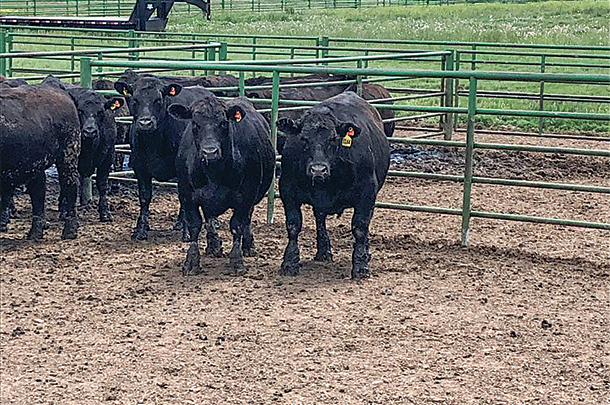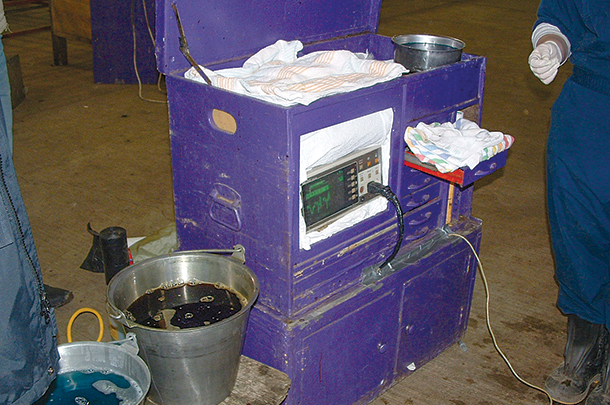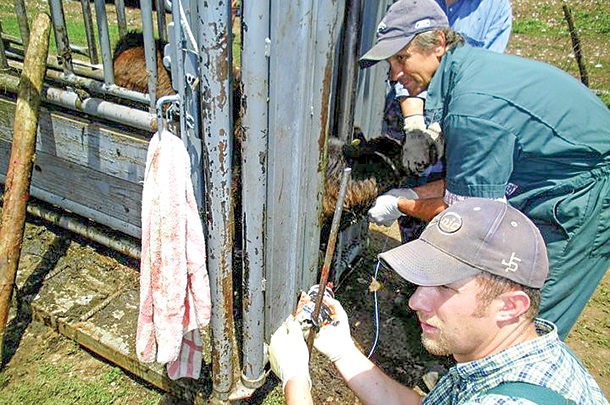Some cattle at high elevations suffer pulmonary artery hypertension (brisket disease), which leads to congestive heart failure. Cattle at low elevations are also susceptible to bovine congestive heart failure (BCHF).
This condition is often seen in feedlot cattle. BCHF is an untreatable and sometimes fatal condition, pulmonary hypertension that results in right ventricular failure, but it may begin with left-heart dysfunction in cattle at low and moderate altitudes. This makes it different from right heart failure at high altitudes because BCHF in the feedlot affects both sides of the heart.
Researchers at the USDA-ARS, U.S. Meat Animal Research Center (MARC) and Great Plains Veterinary Educational Center at Clay Center, Nebraska, have been studying BCHF in feedlot cattle since the 1970s – it’s not a new disease but is now seen more frequently. There are more reports of cattle dying of BCHF at low altitudes, such as in Nebraska feedlots at 1,600 feet and northwest Iowa at 1,000 feet.
Dr. Greta Krafsur, veterinary pathologist in the department of veterinary and biomedical sciences at South Dakota State University, says congestive heart failure in feedlot cattle was the subject of her Ph.D. dissertation research. She did a lot of work with researchers at the Genetics, Breeding and Animal Health Research Unit at the USDA-ARS (MARC) and Dale Grotelueschen (University of Nebraska) and researchers at Colorado State University. “This problem is now happening earlier in the feeding period with cattle they’ve studied,” she says.
 These feedlot steers show signs of bovine congestive heart failure, especially the steer on the right. Photo provided by Milt Thomas.
These feedlot steers show signs of bovine congestive heart failure, especially the steer on the right. Photo provided by Milt Thomas.Those cattle can be identified before they show clinical signs. “Their pulmonary arterial pressures (PAP) are already high, early in the feeding period. Clinically, high mountain disease and BCHF in feedlot cattle look the same,” says Krafsur. “They have brisket edema, belly edema, bounding jugular pulse and may have diarrhea. They start losing weight and performance decreases, with diminished carcass traits.”
Dr. Milt Thomas of Colorado State University says the heart problems in high mountain disease happen much earlier in the animal’s life, while BCHF generally occurs in the finishing phase in a feedlot. “High mountain ‘brisket disease’ can appear in a calf or yearling – animals that are growing rapidly. These animals are lean, compared to a finishing animal. The feedlot animal is a very different creature, at the top of the growth curve, becoming fat,” he says.
“We’ve been doing a USDA-funded project to try to understand feedlot heart disease. Our feedlot facility in Akron, Colorado, is at 4,100 feet elevation. One client feeds about 500 commercial Angus steers there every year, with high incidence of feedlot heart disease. That client allowed us to buy 107 steers for a research project,” says Thomas.
“We treated those steers like any other steers in the feedlot, thinking they could be a good representation of what’s happening with feedlot heart disease. We’ve now taken them to slaughter and have our initial data – and found feedlot heart disease.”
 Examples of equipment for PAP testing. Photo provided by Mark Stayton.
Examples of equipment for PAP testing. Photo provided by Mark Stayton.This set of steers started on the plains, finished on the plains and never were in high mountains. “We PAP-tested them like we do with high mountain cattle, and were very surprised to find a lot of high-PAP cattle in these steers,” Thomas says. “There were so many that we created a high-PAP and a low-PAP group and brought them to our Fort Collins facility to study intensively,” Thomas says.
“The high-PAP steers had poor average daily gain in final phases of feeding, and feed conversion was terrible. By contrast, the low-PAP steers had good average daily gain, good feed conversion, etc. The closer they got to finishing, the more the feedlot performance declined on the high-PAP steers,” he says.
“Out of 107 steers, death loss was 5.5 percent. One calf died early, but the others died late in the feeding period when they should have been past the early risks, and they all died from feedlot heart disease.”
After the feeding period, the high-PAP and low-PAP steers were slaughtered at the new facility on the CSU campus (Global Food Innovation Center). “Though some died, we still had 12 high-PAP and 12 low-PAP steers we slaughtered to study their heart and lung tissues and performance data,” says Thomas.
“All the low-PAP animals had normal-looking hearts, but all the high-PAP steers had severely malformed hearts. These were the steers that made it to slaughter; it doesn’t count the ones that died. All the steers that died had severely malformed hearts,” he says.
Effect on retail meet
Dr. Mahesh Nair and colleagues at Colorado State University are publishing a paper (“Pulmonary arterial pressure in cattle influences beef color during retail display”) detailing results of extensive testing of meat from these two groups. The meat from high-PAP steers had poor color (gray) and shorter shelf life than meat from the low-PAP steers (which was normal red in color).
This study was an important first effort in evaluating meat from high-PAP versus low-PAP animals. “When we compare cattle in the feedlot that are healthy versus those suffering from pulmonary hypertension, we realize this is a disease, and we don’t want sick animals, but a lot of high-PAP animals make it to slaughter. So we need to know the impact on their meat,” he says.
One researcher, Dr. Mahesh Nair (a food chemist in the CSU Department of Animal Sciences) and graduate student Chaoya Zhai took a strip loin from each high-PAP and low-PAP steer and did a full workup on composition plus shelf life, to nine days in a meat cooler in a store. The high-PAP animals had shorter shelf life, eight days instead of nine. Tenderness was not affected, but those steaks didn’t keep as long.
“We slaughter animals in one location and ship the meat to another place, and after it’s on the grocery shelf it may be a few more days before someone buys it and takes it home and cooks it. Shorter shelf life is not a good thing,” Thomas says.
“This past year, we’ve worked on our data, but haven’t been able to finish it due to the COVID-19 shutdown. We’ve all been working from home since March, so this has cut into our progress,” he says.
Movement of seedstock
In another study, Taylor Zimprich and colleagues at CSU did multiple PAP measurements on beef bulls in Colorado at various altitudes, with interesting results. “Today, people PAP-test many animals but just do one test, and that’s the only measure for the animal’s life. That’s like taking a person’s blood pressure and saying that’s what it will be for your life. This study showed that when we moved bulls from moderate altitude to high altitude, their PAP scores went up, and when we moved them back to moderate altitude, some bulls’ scores went down, but some were starting to have malformations in their heart and lungs.”
Some of them recovered with no problems, but others have damage that will impact their health for the rest of their lives. “Producers go to a bull sale and buy a bull that had a low PAP score and think he’s a good one for the rest of his life. Maybe not. It may depend on how often they move him up and down in altitude or whether he gets a respiratory disease. The PAP score is dynamic and can change,” says Thomas.
If a person buys a low-PAP bull to sire daughters or calves for the feedlot, and this tendency is genetic, offspring may have problems. “This is a big piece of the puzzle we don’t have yet; we’re still working on it. If we PAP-test an animal at high altitude, what does that mean for their PAP in the feedlot?” he asks.
“PAP is a measure of heart/lung actions, but we don’t know if high PAP in a feedlot animal is the same as high PAP at altitude. There’s some logic to say they are similar, but these are two very different creatures.” People wonder, however, if this might be a red flag, even if it’s not exactly the same.
“A lot more research needs to be done. A yearling bull, though ultrasound can tell us he has good marbling, is still a very lean creature and doesn’t have a lot of body fat – not like a feedlot steer. The feedlot steer is a very obese creature. We still have a lot to learn about this,” says Thomas.
These studies are important because none of the steers at the Akron feedlot were ever at high altitude. Many people still have misconceptions that this is just a high-altitude disease, yet most cattle that come to feedlots have never been at high altitude.









